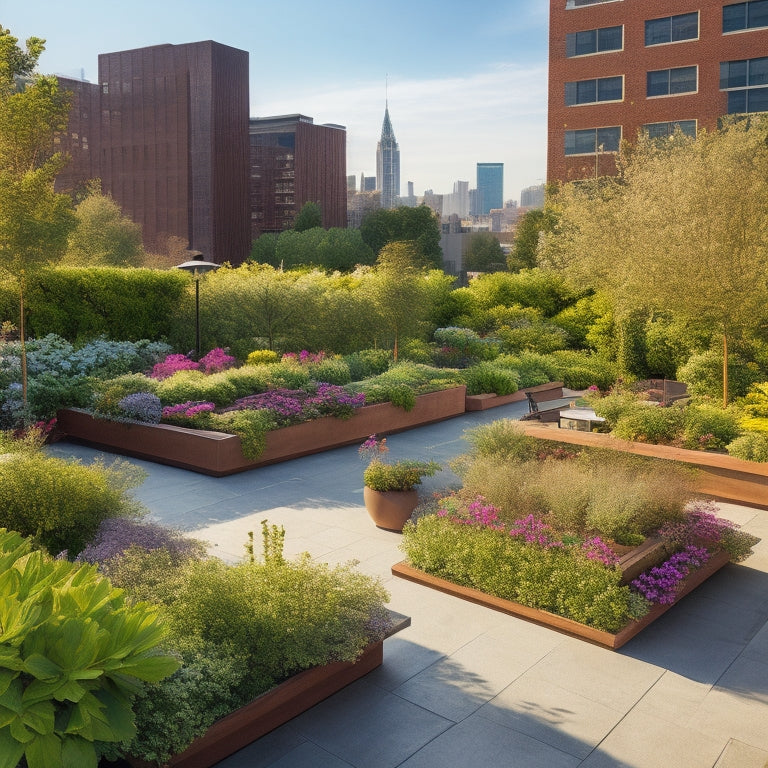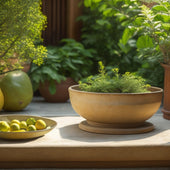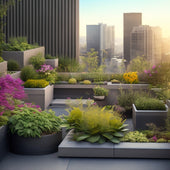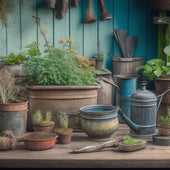
5 Best Rooftop Garden Designs for Seniors
Share
You can create a rooftop garden that's tailored to your needs as a senior by incorporating accessible raised bed designs, senior-friendly container gardens, and rooftop herb garden ideas. Raised beds with a height of 24-30 inches enable comfortable reaching, while wheelchair-accessible designs guarantee inclusivity. Container gardens offer versatility and low maintenance, with options like vertical planters and self-watering pots. For easy maintenance, consider tiered planters, wall-mounted trellises, and low-upkeep plants like succulents. As you explore these designs, you'll discover how to adapt your garden to your physical needs, enhancing your overall well-being.
Accessible Raised Bed Designs
You can create accessible raised beds with a height of 24-30 inches, enabling seniors to comfortably reach the plants without straining their backs or knees. These elevated planter options facilitate easy gardening, reducing the need for bending, stooping, or kneeling.
When designing wheelchair accessible raised beds, consider a width of at least 36 inches to accommodate wheelchair clearance. A flat, stable surface and a non-slip material, such as textured wood or composite, will ensure safe and easy navigation.
Incorporate lowered or recessed areas for seating, allowing seniors to take breaks and rest while gardening. You can also add grab bars or handrails for additional support and balance. To maximize accessibility, position raised beds in a way that allows for easy transfer from a wheelchair to a seated position.
Senior-Friendly Container Gardens
Senior-friendly container gardens offer a versatile and low-maintenance alternative to raised beds, perfectly suited for small rooftop spaces or balconies where mobility is limited. You can create a thriving garden in a small area, using containers that are easy to reach and maintain.
Here are some popular container options for seniors:
| Container Type | Benefits | Space Requirements |
|---|---|---|
| Vertical Planters | Maximize space, easy to water | 2-3 sq. ft. |
| Hanging Baskets | Add visual interest, reduce weight | 1-2 sq. ft. |
| Window Boxes | Increase accessibility, easy to harvest | 1-2 sq. ft. |
| Self-Watering Pots | Reduce maintenance, improve yields | 1-2 sq. ft. |
| Tiered Planters | Create a visually appealing display | 2-3 sq. ft. |
When choosing containers, consider factors like weight, size, and material. Look for lightweight, durable options with good drainage and aeration. You can also add features like built-in irrigation systems or trellises to make maintenance even easier. By selecting the right containers for your needs, you can create a beautiful and functional rooftop garden that brings joy and relaxation to your daily life.
Rooftop Herb Garden Ideas
To complement your senior-friendly container gardens, a rooftop herb garden can provide an abundance of fresh flavors and fragrances, carefully curated to enhance your daily meals and cooking experiences.
When designing your rooftop herb garden, consider vertical planter options to maximize space and create a visually appealing display. You can choose from a variety of materials, such as wood, metal, or recycled plastic, to suit your style and budget.
For a more whimsical touch, DIY hanging herb gardens are a great option. Simply attach small pots or planters to a trellis or a wall-mounted rack, and you'll have a beautiful, space-saving herb garden that's easy to maintain.
Easy Maintenance Space Savers
By incorporating space-saving elements, such as tiered planters and wall-mounted trellises, seniors can create a rooftop garden that maximizes its footprint while minimizing upkeep. This is especially important for seniors, who may not have the physical ability or desire to maintain a large garden.
To create an easy-to-maintain rooftop garden, consider the following space-saving strategies:
-
Use vertical planters: These planters allow you to grow a variety of plants in a small footprint, making the most of your rooftop space.
-
Opt for miniature landscapes: Create a smaller, self-contained garden in a planter or container, reducing the need for extensive maintenance.
-
Install wall-mounted trellises: Train vining plants to grow up trellises, adding visual interest without taking up valuable floor space.
- Choose low-maintenance plants: Select plants that require less watering, pruning, and fertilizing, such as succulents or drought-tolerant species.
Adaptive Gardening Solutions
How can adaptive gardening solutions empower you to continue enjoying rooftop gardening despite physical limitations, allowing you to maintain independence and connection with nature?
By incorporating ergonomic tools and therapeutic benefits, you can overcome physical barriers and continue to reap the rewards of rooftop gardening. For instance, using raised beds or vertical planters can reduce strain on your back and joints, while ergonomic hand tools and grips can reduce fatigue and discomfort.
When designing your rooftop garden, consider weather conditions and seasonal plantings to guarantee a thriving and low-maintenance space. Incorporate drought-tolerant plants and succulents for hot summer months, and switch to cool-season crops during the winter.
This won't only reduce maintenance but also provide a sense of accomplishment and connection to the changing seasons. By adapting your gardening approach to your physical needs, you can continue to enjoy the therapeutic benefits of rooftop gardening, from reducing stress and anxiety to improving cognitive function and overall well-being.
Frequently Asked Questions
Can Rooftop Gardens Withstand Extreme Weather Conditions?
You'll need to guarantee your rooftop garden can withstand extreme weather by implementing waterproofing solutions, such as membrane coatings and drainage systems, and considering greenhouse options with reinforced frames and shatter-resistant glazing.
How Do I Ensure Rooftop Structural Integrity for Gardening?
'Before you start digging, remember that a rooftop garden's worst enemy is weight, not beauty! You'll need to guarantee soil composition won't compromise the structure, install a proper drainage system, and balance weight distribution with safety measures to avoid disaster.'
Are Rooftop Gardens Noisy and Disturbing to Neighbors?
When designing your rooftop garden, you'll want to contemplate noise pollution and its impact on community harmony. You'll need to ponder neighbor considerations, like sound-absorbing materials and strategically placed rooftop decor to minimize disturbance.
Can I Have a Rooftop Garden in a Rented Apartment Building?
You're likely one of the 70% of renters who want to stay in their current building, so it's worth exploring: check your lease for rooftop garden permissions, and research local apartment building regulations to guarantee your green oasis is allowed.
Do Rooftop Gardens Increase Property Taxes or Insurance Rates?
You'll want to know that installing a rooftop garden can increase your property value, leading to potential tax implications, and may also affect your insurance coverage, resulting in a rate impact, so researching and planning carefully is crucial.
Related Posts
-

10 Natural Ways to Clean Your Planters
You can transform your planters from grimy to gleaming with these 10 natural cleaning solutions. Mix baking soda and ...
-

10 Natural Ways to Clean Your Planters
You can transform your planters from grimy to gleaming with these 10 natural cleaning solutions. Mix baking soda and ...
-

10 Natural Ways to Clean Your Planters
You can transform your planters from grimy to gleaming with these 10 natural cleaning solutions. Mix baking soda and ...
-

10 Natural Ways to Clean Your Planters
You can transform your planters from grimy to gleaming with these 10 natural cleaning solutions. Mix baking soda and ...
-

10 Natural Ways to Clean Your Planters
You can transform your planters from grimy to gleaming with these 10 natural cleaning solutions. Mix baking soda and ...
-

10 Natural Ways to Clean Your Planters
You can transform your planters from grimy to gleaming with these 10 natural cleaning solutions. Mix baking soda and ...
-

10 Natural Ways to Clean Your Planters
You can transform your planters from grimy to gleaming with these 10 natural cleaning solutions. Mix baking soda and ...
-

10 Natural Ways to Clean Your Planters
You can transform your planters from grimy to gleaming with these 10 natural cleaning solutions. Mix baking soda and ...
-

10 Natural Ways to Clean Your Planters
You can transform your planters from grimy to gleaming with these 10 natural cleaning solutions. Mix baking soda and ...
-

10 Natural Ways to Clean Your Planters
You can transform your planters from grimy to gleaming with these 10 natural cleaning solutions. Mix baking soda and ...
-

10 Natural Ways to Clean Your Planters
You can transform your planters from grimy to gleaming with these 10 natural cleaning solutions. Mix baking soda and ...
-

10 Natural Ways to Clean Your Planters
You can transform your planters from grimy to gleaming with these 10 natural cleaning solutions. Mix baking soda and ...
-

10 Natural Ways to Clean Your Planters
You can transform your planters from grimy to gleaming with these 10 natural cleaning solutions. Mix baking soda and ...
-

10 Natural Ways to Clean Your Planters
You can transform your planters from grimy to gleaming with these 10 natural cleaning solutions. Mix baking soda and ...
-

10 Natural Ways to Clean Your Planters
You can transform your planters from grimy to gleaming with these 10 natural cleaning solutions. Mix baking soda and ...
-

10 Natural Ways to Clean Your Planters
You can transform your planters from grimy to gleaming with these 10 natural cleaning solutions. Mix baking soda and ...
-

10 Natural Ways to Clean Your Planters
You can transform your planters from grimy to gleaming with these 10 natural cleaning solutions. Mix baking soda and ...
-

10 Natural Ways to Clean Your Planters
You can transform your planters from grimy to gleaming with these 10 natural cleaning solutions. Mix baking soda and ...
-

10 Natural Ways to Clean Your Planters
You can transform your planters from grimy to gleaming with these 10 natural cleaning solutions. Mix baking soda and ...
-

10 Natural Ways to Clean Your Planters
You can transform your planters from grimy to gleaming with these 10 natural cleaning solutions. Mix baking soda and ...
-

10 Natural Ways to Clean Your Planters
You can transform your planters from grimy to gleaming with these 10 natural cleaning solutions. Mix baking soda and ...
-

10 Natural Ways to Clean Your Planters
You can transform your planters from grimy to gleaming with these 10 natural cleaning solutions. Mix baking soda and ...
-

10 Natural Ways to Clean Your Planters
You can transform your planters from grimy to gleaming with these 10 natural cleaning solutions. Mix baking soda and ...
-

10 Natural Ways to Clean Your Planters
You can transform your planters from grimy to gleaming with these 10 natural cleaning solutions. Mix baking soda and ...
-

10 Natural Ways to Clean Your Planters
You can transform your planters from grimy to gleaming with these 10 natural cleaning solutions. Mix baking soda and ...
-

10 Natural Ways to Clean Your Planters
You can transform your planters from grimy to gleaming with these 10 natural cleaning solutions. Mix baking soda and ...
-

10 Natural Ways to Clean Your Planters
You can transform your planters from grimy to gleaming with these 10 natural cleaning solutions. Mix baking soda and ...
-

10 Natural Ways to Clean Your Planters
You can transform your planters from grimy to gleaming with these 10 natural cleaning solutions. Mix baking soda and ...
-

10 Natural Ways to Clean Your Planters
You can transform your planters from grimy to gleaming with these 10 natural cleaning solutions. Mix baking soda and ...
-

10 Natural Ways to Clean Your Planters
You can transform your planters from grimy to gleaming with these 10 natural cleaning solutions. Mix baking soda and ...
-

10 Natural Ways to Clean Your Planters
You can transform your planters from grimy to gleaming with these 10 natural cleaning solutions. Mix baking soda and ...
-

10 Natural Ways to Clean Your Planters
You can transform your planters from grimy to gleaming with these 10 natural cleaning solutions. Mix baking soda and ...
-

10 Natural Ways to Clean Your Planters
You can transform your planters from grimy to gleaming with these 10 natural cleaning solutions. Mix baking soda and ...
-

10 Natural Ways to Clean Your Planters
You can transform your planters from grimy to gleaming with these 10 natural cleaning solutions. Mix baking soda and ...
-

10 Natural Ways to Clean Your Planters
You can transform your planters from grimy to gleaming with these 10 natural cleaning solutions. Mix baking soda and ...
-

Irrigation System Design Ideas for Concrete Planters
As you design an irrigation system for your concrete planters, you'll need to balance drainage, moisture retention, a...
-

Irrigation System Design Ideas for Concrete Planters
As you design an irrigation system for your concrete planters, you'll need to balance drainage, moisture retention, a...
-

Irrigation System Design Ideas for Concrete Planters
As you design an irrigation system for your concrete planters, you'll need to balance drainage, moisture retention, a...
-

Irrigation System Design Ideas for Concrete Planters
As you design an irrigation system for your concrete planters, you'll need to balance drainage, moisture retention, a...
-

Irrigation System Design Ideas for Concrete Planters
As you design an irrigation system for your concrete planters, you'll need to balance drainage, moisture retention, a...
-

Irrigation System Design Ideas for Concrete Planters
As you design an irrigation system for your concrete planters, you'll need to balance drainage, moisture retention, a...
-

Irrigation System Design Ideas for Concrete Planters
As you design an irrigation system for your concrete planters, you'll need to balance drainage, moisture retention, a...
-

Irrigation System Design Ideas for Concrete Planters
As you design an irrigation system for your concrete planters, you'll need to balance drainage, moisture retention, a...
-

Irrigation System Design Ideas for Concrete Planters
As you design an irrigation system for your concrete planters, you'll need to balance drainage, moisture retention, a...
-

Irrigation System Design Ideas for Concrete Planters
As you design an irrigation system for your concrete planters, you'll need to balance drainage, moisture retention, a...
-

Irrigation System Design Ideas for Concrete Planters
As you design an irrigation system for your concrete planters, you'll need to balance drainage, moisture retention, a...
-

Irrigation System Design Ideas for Concrete Planters
As you design an irrigation system for your concrete planters, you'll need to balance drainage, moisture retention, a...
-

Irrigation System Design Ideas for Concrete Planters
As you design an irrigation system for your concrete planters, you'll need to balance drainage, moisture retention, a...
-

Irrigation System Design Ideas for Concrete Planters
As you design an irrigation system for your concrete planters, you'll need to balance drainage, moisture retention, a...
-

Irrigation System Design Ideas for Concrete Planters
As you design an irrigation system for your concrete planters, you'll need to balance drainage, moisture retention, a...
-

Irrigation System Design Ideas for Concrete Planters
As you design an irrigation system for your concrete planters, you'll need to balance drainage, moisture retention, a...
-

Irrigation System Design Ideas for Concrete Planters
As you design an irrigation system for your concrete planters, you'll need to balance drainage, moisture retention, a...
-

Irrigation System Design Ideas for Concrete Planters
As you design an irrigation system for your concrete planters, you'll need to balance drainage, moisture retention, a...
-

Irrigation System Design Ideas for Concrete Planters
As you design an irrigation system for your concrete planters, you'll need to balance drainage, moisture retention, a...
-

Irrigation System Design Ideas for Concrete Planters
As you design an irrigation system for your concrete planters, you'll need to balance drainage, moisture retention, a...
-

Irrigation System Design Ideas for Concrete Planters
As you design an irrigation system for your concrete planters, you'll need to balance drainage, moisture retention, a...
-

Irrigation System Design Ideas for Concrete Planters
As you design an irrigation system for your concrete planters, you'll need to balance drainage, moisture retention, a...
-

Irrigation System Design Ideas for Concrete Planters
As you design an irrigation system for your concrete planters, you'll need to balance drainage, moisture retention, a...
-

Irrigation System Design Ideas for Concrete Planters
As you design an irrigation system for your concrete planters, you'll need to balance drainage, moisture retention, a...
-

Irrigation System Design Ideas for Concrete Planters
As you design an irrigation system for your concrete planters, you'll need to balance drainage, moisture retention, a...
-

Irrigation System Design Ideas for Concrete Planters
As you design an irrigation system for your concrete planters, you'll need to balance drainage, moisture retention, a...
-

Irrigation System Design Ideas for Concrete Planters
As you design an irrigation system for your concrete planters, you'll need to balance drainage, moisture retention, a...
-

Irrigation System Design Ideas for Concrete Planters
As you design an irrigation system for your concrete planters, you'll need to balance drainage, moisture retention, a...
-

Irrigation System Design Ideas for Concrete Planters
As you design an irrigation system for your concrete planters, you'll need to balance drainage, moisture retention, a...
-

Irrigation System Design Ideas for Concrete Planters
As you design an irrigation system for your concrete planters, you'll need to balance drainage, moisture retention, a...
-

Irrigation System Design Ideas for Concrete Planters
As you design an irrigation system for your concrete planters, you'll need to balance drainage, moisture retention, a...
-

Inspect and Revive Second-Hand Tools for Planters
When inspecting and reviving second-hand tools for planters, prioritize tools with sturdy builds and functional parts...
-

Inspect and Revive Second-Hand Tools for Planters
When inspecting and reviving second-hand tools for planters, prioritize tools with sturdy builds and functional parts...
-

Inspect and Revive Second-Hand Tools for Planters
When inspecting and reviving second-hand tools for planters, prioritize tools with sturdy builds and functional parts...
-

Inspect and Revive Second-Hand Tools for Planters
When inspecting and reviving second-hand tools for planters, prioritize tools with sturdy builds and functional parts...
-

Inspect and Revive Second-Hand Tools for Planters
When inspecting and reviving second-hand tools for planters, prioritize tools with sturdy builds and functional parts...
-

Inspect and Revive Second-Hand Tools for Planters
When inspecting and reviving second-hand tools for planters, prioritize tools with sturdy builds and functional parts...
-

Inspect and Revive Second-Hand Tools for Planters
When inspecting and reviving second-hand tools for planters, prioritize tools with sturdy builds and functional parts...
-

Inspect and Revive Second-Hand Tools for Planters
When inspecting and reviving second-hand tools for planters, prioritize tools with sturdy builds and functional parts...
-

Inspect and Revive Second-Hand Tools for Planters
When inspecting and reviving second-hand tools for planters, prioritize tools with sturdy builds and functional parts...
-

Inspect and Revive Second-Hand Tools for Planters
When inspecting and reviving second-hand tools for planters, prioritize tools with sturdy builds and functional parts...
-

Inspect and Revive Second-Hand Tools for Planters
When inspecting and reviving second-hand tools for planters, prioritize tools with sturdy builds and functional parts...
-

Inspect and Revive Second-Hand Tools for Planters
When inspecting and reviving second-hand tools for planters, prioritize tools with sturdy builds and functional parts...
-

Inspect and Revive Second-Hand Tools for Planters
When inspecting and reviving second-hand tools for planters, prioritize tools with sturdy builds and functional parts...
-

Inspect and Revive Second-Hand Tools for Planters
When inspecting and reviving second-hand tools for planters, prioritize tools with sturdy builds and functional parts...
-

Inspect and Revive Second-Hand Tools for Planters
When inspecting and reviving second-hand tools for planters, prioritize tools with sturdy builds and functional parts...
-

Inspect and Revive Second-Hand Tools for Planters
When inspecting and reviving second-hand tools for planters, prioritize tools with sturdy builds and functional parts...
-

Inspect and Revive Second-Hand Tools for Planters
When inspecting and reviving second-hand tools for planters, prioritize tools with sturdy builds and functional parts...
-

Inspect and Revive Second-Hand Tools for Planters
When inspecting and reviving second-hand tools for planters, prioritize tools with sturdy builds and functional parts...
-

Inspect and Revive Second-Hand Tools for Planters
When inspecting and reviving second-hand tools for planters, prioritize tools with sturdy builds and functional parts...
-

Inspect and Revive Second-Hand Tools for Planters
When inspecting and reviving second-hand tools for planters, prioritize tools with sturdy builds and functional parts...
-

Inspect and Revive Second-Hand Tools for Planters
When inspecting and reviving second-hand tools for planters, prioritize tools with sturdy builds and functional parts...
-

Inspect and Revive Second-Hand Tools for Planters
When inspecting and reviving second-hand tools for planters, prioritize tools with sturdy builds and functional parts...
-

Inspect and Revive Second-Hand Tools for Planters
When inspecting and reviving second-hand tools for planters, prioritize tools with sturdy builds and functional parts...
-

Inspect and Revive Second-Hand Tools for Planters
When inspecting and reviving second-hand tools for planters, prioritize tools with sturdy builds and functional parts...
-

Inspect and Revive Second-Hand Tools for Planters
When inspecting and reviving second-hand tools for planters, prioritize tools with sturdy builds and functional parts...
-

Inspect and Revive Second-Hand Tools for Planters
When inspecting and reviving second-hand tools for planters, prioritize tools with sturdy builds and functional parts...


